Although currently beleaguered by low prices, increased competition from foreign producers, and continuing disputes regarding access to the American market, forest industries still employ over 280,000 Canadians and are the economic drivers of many single-industry communities.['1']
Saskatchewan, usually envisioned as a province of grasslands, is actually more than half forest. Large boreal forests of spruce, birch, aspen, and jack pine extend in a band across north central Saskatchewan. The commercial value of these timber resources has long been recognized and exploited. Saskatchewan's first sawmill was established at Prince Albert in 1877. Other Saskatchewan communities dependent upon Saskatchewan's forest industry are Big River, Carrot River, Hudson Bay and Meadow Lake. Most early sawmills were sited near rivers so that logs could be delivered by flotation.
Much of the initial work in the province's timber industry occurred during the winter months when it was easier to transport logs over snow and ice and when there were more men available, especially farm workers, seeking paid employment.
In 2007 Saskatchewan's forestry sector employed over 2,400 -- 700 in the primary forestry sector and 1,700 in a secondary sector, including the production of lumber, pulp and paper, plywood and oriented strand board, flooring and millwork.['2'] Since 2006 there have been a number of large shutdowns and closures of lumber mills and pulp and paper plants in northern Saskatchewan, including the closure of the Weyerhaeuser pulp and paper mill in Prince Albert affecting which affected 690 jobs.
Many occupations exist in the forestry industry beyond the initial cutting and transportation of logs. After logs are trucked to a sawmill they are cut and stripped of bark, then sawed into boards of different sizes before being allowed to dry in bins and kilns. Lumber is also inspected and graded at sawmills before being shipped to market in bundles by truck or train.
Logs may also be cut into fence posts, poles, and logs for cabin construction and treated with preservatives. The forest industry contributes to the reforestation or regeneration work of harvested areas, with fees paid to a provincial Forest Renewal Fund.
Footnotes
↑ ['1'] Softwood Lumber. Accessed April 16, 2010.
↑ ['2'] Opportunity Now Saskatchewan. Accessed April 16, 2010.


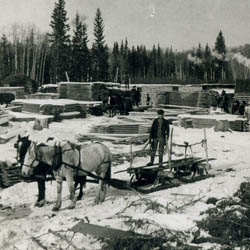
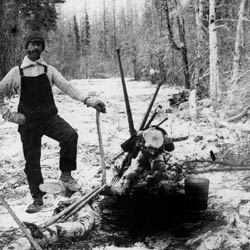
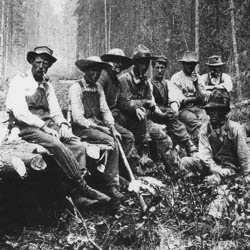
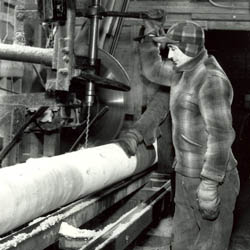
![Felling the Spruce, ['190-?']](cropthumbs/E-415-p01.jpg)
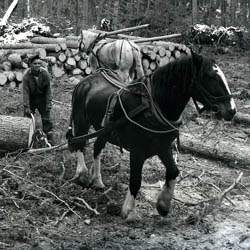
![Lumberjacks Aboard Winter Load, ['19--?']](cropthumbs/LH-1123.jpg)
![Four Young Cooks, ['ca.1910s']](cropthumbs/R-A1783.jpg)
![Cutting Logs with Band Saw, ['19--']](cropthumbs/E-410-p01.jpg)
![Small Sawmill Shop, ['ca. 1910s']](cropthumbs/R-A1667.jpg)